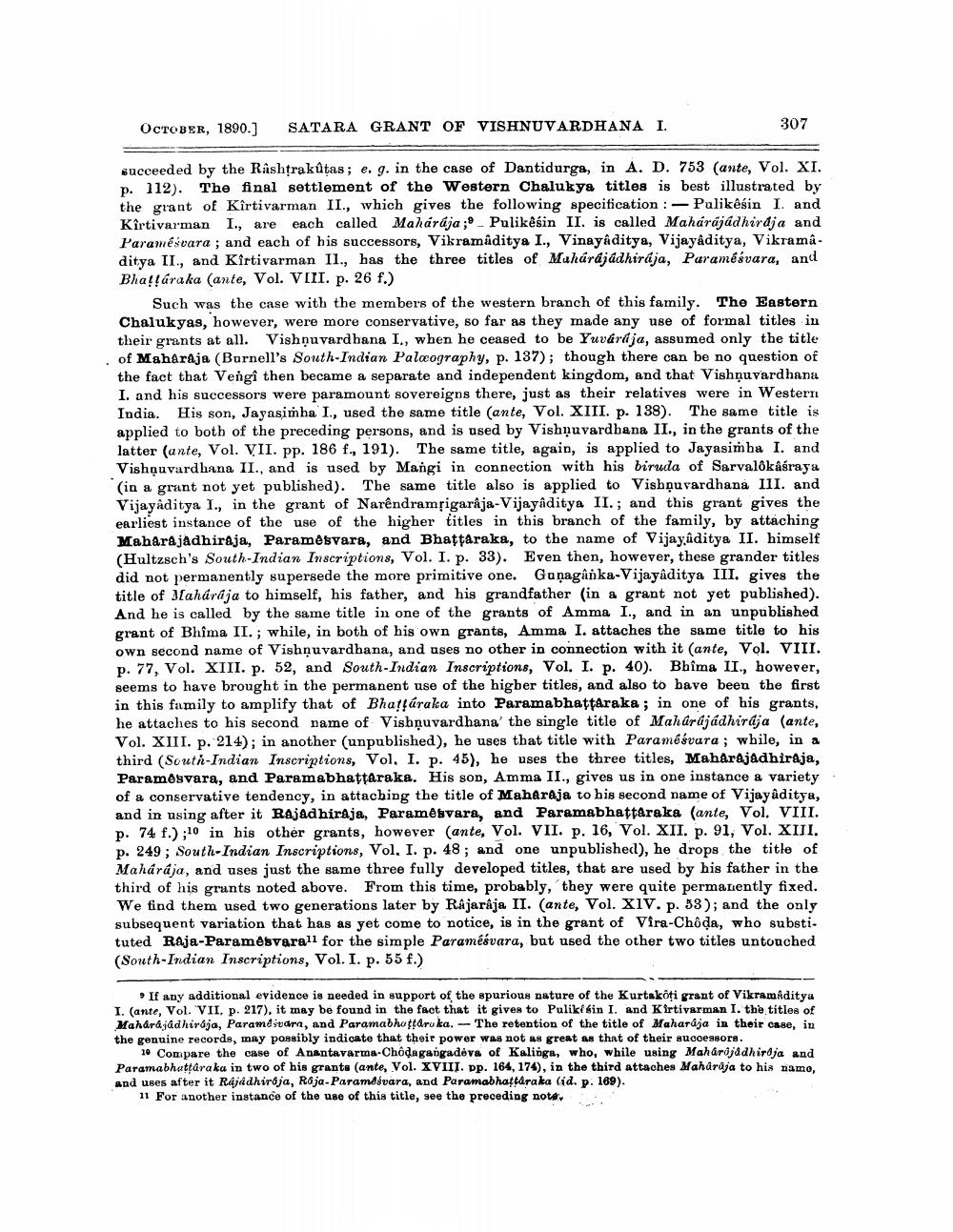________________
OCTOBER, 1890.)
SATARA GRANT OF VISHNUVARDHANA I.
307
succeeded by the Rashtrakûtas; e. g. in the case of Dantidurga, in A. D. 753 (ante, Vol. XI. p. 112). The final settlement of the Western Chalukya titles is best illustrated by the grant of Kirtivarman II., which gives the following specification : - Palikesin I. and Kirtivarman I., are each called Maharāja ;'_ Pulikêśin II. is called Mahárájádhiraja and Paraméśvara ; and each of his successors, Vikramaditya I., Vinayaditya, Vijayaditya, Vikramaditya II., and Kirtivarman II., has the three titles of Muhárajadhiraja, Paraméśvara, and Bha!!áraka (ante, Vol. VIII. p. 26 f.)
Such was the case with the members of the western branch of this family. The Eastern Chalukyas, however, were more conservative, so far as they made any use of formal titles in their grants at all. Vishņuvardhana I., when he ceased to be Yuvárdja, assumed only the title . of Maharaja (Barnell's South Indian Palæography, p. 137); though there can be no question of
the fact that Vengî then became a separate and independent kingdom, and that Vishņuvardhana I. and his successors were paramount sovereigns there, just as their relatives were in Western India. His son, Jayasimha I., used the same title (ante, Vol. XIII. p. 138). The same title is applied to both of the preceding persons, and is used by Vishnuvardhana II., in the grants of the latter (ante, Vol. VII. pp. 186 f., 191). The same title, again, is applied to Jayasimba I. and Vishậuvardhana II., and is used by Mangi in connection with his biruda of Sarvalókásraya (in a grant not yet published). The same title also is applied to Vishņuvardhana Ill. and Vijayaditya I., in the grant of Narendramrigarâja-Vijayaditya II.; and this grant gives the earliest instance of the use of the higher titles in this branch of the family, by attaching Maharajadhiraja, Paramèsvara, and Bhattaraka, to the name of Vijayaditya II. himself (Hultzsch's South Indian Inscriptions, Vol. I. p. 33). Even then, however, these grander titles did not permanently supersede the more primitive one. Gunagånka-Vijayaditya III. gives the title of Maharaja to himself, his father, and his grandfather in a grant not yet published). And he is called by the same title in one of the grants of Amma I., and in an unpublished grant of Bhima II. ; while, in both of his own grants, Amma I. attaches the same title to his own second name of Vishņuvardhana, and uses no other in connection with it (ante, Vol. VIII. p. 77, Vol. XIII. p. 52, and South Indian Inscriptions, Vol. I. p. 40). Bbîma II., however, seems to have brought in the permanent use of the higber titles, and also to bave been the first in this family to amplify that of Bhatļáraka into Paramabhattaraka; in one of his grants, he attaches to his second name of Vishņuvardhana' the single title of Mahúrájádhiraja (ante, Vol. XIII. p. 214); in another (unpublished), he uses that title with Paraméśvara; while, in a third (South-Indian Inscriptions, Vol. I. p. 45), he uses the three titles, Maharajadhiraja, Paramèsvara, and Paramabhattaraka. His son, Amma II., gives us in one instance a variety of a conservative tendency, in attaching the title of Maharaja to his second name of Vijayaditya, and in using after it Rajadhiraja, Paramê vara, and Paramabhattaraka (ante, Vol. VIII. p. 74 f.);10 in his other grants, however (ante, Vol. VII. p. 16, Vol. XII. p. 91, Vol. XIII. p. 249 ; South Indian Inscriptions, Vol. I. p. 48; and one unpublished), he drops the title of Mahárája, and uses just the same three fully developed titles, that are used by his father in the third of his grants noted above. From this time, probably, they were quite permanently fixed. We find them used two generations later by Rajaraja II. (ante, Vol. XIV. p. 53); and the only subsequent variation that has as yet come to notice, is in the grant of Vira-Choda, who substi. tuted Raja-Paramèsvarall for the simple Paraméśvara, but used the other two titles untouched (South Indian Inscriptions, Vol. I. p. 55 f.)
If any additional evidence is needed in support of the spurious nature of the Kurtaköti grant of Vikramaditya
hat it gives to Puliki bin I. and Kirtivarman I. the titles of Maharájádhiraja, Paramésame, and Paramabhottaro ka. - The retention of the title of Maharaja in their case, in the genuine records, may possibly indicate that their power was not as great as that of their successors.
le Compare the case of Anantavarma-Chôdagangadeva of Kalinga, who, while using Maharajadhiraja and Paramabhattáraka in two of his grants (ante, Vol. XVIII. pp. 164, 174), in the third attaches Maharaja to his namo, and uses after it Rajadhiraja, Raja-Paramdsvara, and Paramabhadraka lid. p. 169).
11 For another instance of the use of this title, see the preceding note s




